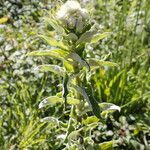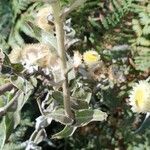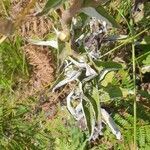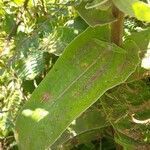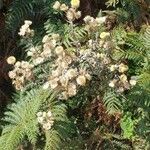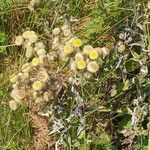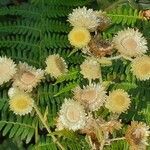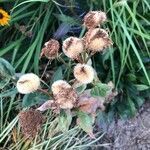Stout biennial herb, foetid, stem simple or sparingly branched from the base, up to ±1 m tall, glandular-pubescent, young parts thinly white-tomentose as well, leafy. Radical leaves more or less rosulate in first year of growth, withered at flowering, up to ±120 x 50 mm, elliptic, apex obtuse to subacute, mucronate, base auriculate-clasping, upper surface sparsely pubescent, lower thinly white-tomentose; cauline leaves mostly 40-90 x 10-25 mm, smaller on the inflorescence branches, lanceolate, apex very acute to acuminate, base broad, cordate-clasping, upper surface rather harshly glandular-pubescent, lower thinly white-tomentose. Heads heterogamous, depressed-globose, ±8-12 mm long, ±15-25 mm across the radiating bracts, many in a large, leafy, spreading corymbose panicle. Involucral bracts in 8-9 series, graded, imbricate, inner much exceeding the flowers, tips acute, glossy, deep to pale lemon-yellow or creamy. Receptacle shortly honeycombed. Flowers 396-835, 54-262 female, 201-694 homogamous, female sometimes outnumbering homogamous. Achenes 0.75-1 mm long, glabrous. Pappus bristles many, equalling corolla, scabrid, bases cohering lightly by patent cilia.
Stout, foetid, up to ± 1 m high, glandular-pubescent, young parts thinly white-tomentose, leafy. Leaves: radical leaves ± rosulate in first year, withered at flowering, up to ± 120 mm long, elliptic, base auriculate-clasping, upper surface ± pubescent, lower surface ± white-tomentose; cauline leaves up to 90 mm long, smaller upwards, lanceolate, base cordate-clasping, upper surface harshly glandular-pubescent. Capitula depressed-globose, ± 8-12 mm long, ± 15-25 mm in diam.; involucral bracts in 8 or 9 series, graded, glossy, deep to pale lemon-yellow or creamy. Flowers 396-835. Floweringtime Oct.-May. Pappus ofmany bristles, bases ± cohering. Cypselae 0.75-1.00 mm long.
Robust, foetid, glandular-hairy biennial to ± 1 m. Leaves oblong-lanceolate, auriculate and clasping, roughly hairy above, grey-woolly beneath. Flower heads disciform, in leafy corymbs, depressed-globose, yellow to cream-coloured, 15-25 mm diam., florets ± 400-800, ovary glabrous.
An erect aromatic branched herb with a pithy stem up to about 5 ft. high
Flower-heads bright yellow, about 1/2 in. across.
Leaves narrow, whitish beneath
